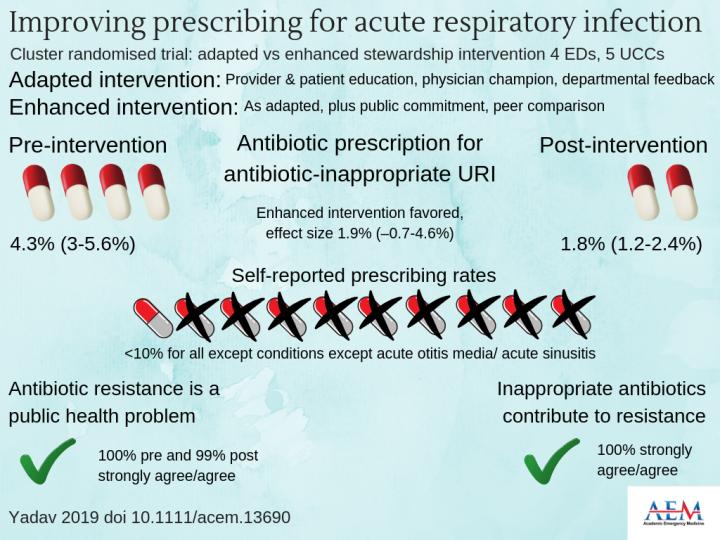
IMAGE: Cluster randomized trial: adapted vs enhanced stewardship intervention in four emergency departments, five urgent care centers. view more
Credit: Kirsty Challen, B.sc., Mbchb, Mres, Ph.d., Lancashire Teaching Hospitals, United Kingdom
DES PLAINES, IL — Antibiotic stewardship interventions for acute respiratory infection (ARI) is feasible and effective and can significantly reduce overuse in the emergency department (ED) and urgent care center (UCC) settings. That is the conclusion of a study to be published in the July 2019 issue of Academic Emergency Medicine (AEM), a journal of the Society for Academic Emergency Medicine (SAEM).
The multicenter interventional study — the first to evaluate the effectiveness of the Core Elements of Outpatient Antibiotic Stewardship when implemented as a bundle — compared two approaches designed to help physicians make better antibiotic-prescribing decisions for viral acute respiratory infections (ARIs) without limiting the choices available.
The lead author of the study is Kabir Yadav, MD, MS, MSHS, Department of Emergency Medicine, Harbor?UCLA Medical Center, Torrance, CA and the Los Angeles Biomedical Research Institute, Torrance, CA.
Yadav, et al. found that while overall performance improvements are still needed in systems with both high and low performers, the study demonstrates that getting to zero inappropriate antibiotic use for ARIs is a potentially achievable goal, and for those institutions with average or high inappropriate prescribing rates, antibiotic overuse can be cut by one?third, with attention to the problem.
Commenting on the study is David A. Talan, MD, professor of medicine in residence (emeritus), David Geffen School of Medicine at UCLA and chair emeritus, Department of Emergency Medicine Faculty, Division of Infectious Diseases, Olive View-UCLA Medical Center:
“While this study did not demonstrate a significant reduction in inappropriate antibiotic use for upper respiratory tract infections with an enhanced educational campaign supplemented by peer comparison, the good news is that its rates are already remarkably low (~5%) in some emergency departments (EDs), and these campaigns appear feasible for EDs seeking more comprehensive models to improve stewardship and for application to other targets, such as urinary treat infections and shotgun empirical broad-spectrum IV treatments (e.g., vancomycin and piperaciilin/tazobactam).”
###
ABOUT ACADEMIC EMERGENCY MEDICINE
Academic Emergency Medicine, the monthly journal of Society for Academic Emergency Medicine, features the best in peer-reviewed, cutting-edge original research relevant to the practice and investigation of emergency care. The above study is published open access and can be downloaded by following the DOI link: 10.1111/acem.13690. Journalists wishing to interview the authors may contact Stacey Roseen at sroseen@saem.org.
ABOUT THE SOCIETY FOR ACADEMIC EMERGENCY MEDICINE
SAEM is a 501(c)(3) not-for-profit organization dedicated to the improvement of care of the acutely ill and injured patient by leading the advancement of academic emergency medicine through education and research, advocacy, and professional development. To learn more, visit saem.org.
Disclaimer: AAAS and EurekAlert! are not responsible for the accuracy of news releases posted to EurekAlert! by contributing institutions or for the use of any information through the EurekAlert system.

